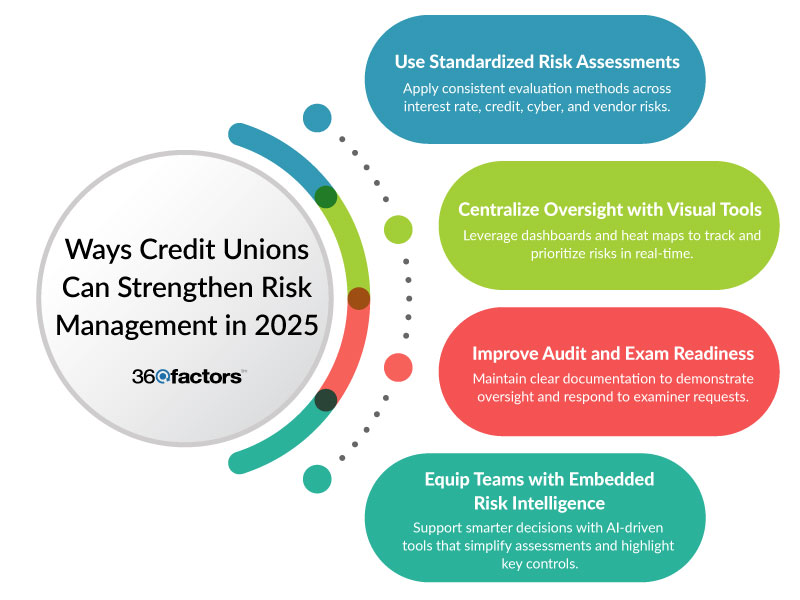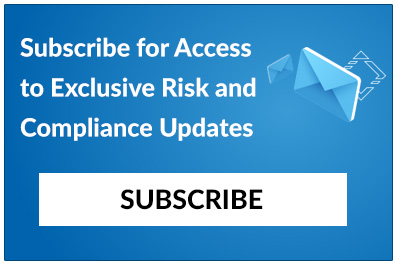Home/ Blog / Effective Risk Management for Credit Unions in 2025: Four Critical Risks and How to Respond
Credit unions in 2025 are operating in a competitive risk environment shaped by economic shifts, operational pressures, and growing technological difficulties. As regulatory expectations evolve and the financial landscape continues to change, financial institutions must be prepared for effective credit union risk management with greater consistency, clarity, and control.
Rising interest rates continue to affect balance sheet performance, particularly for institutions with exposure to long-term, fixed-rate assets. At the same time, liquidity concerns are growing as funding strategies are tested by changing deposit behaviors and supervisory expectations.
Cybersecurity risks are also becoming more frequent and sophisticated. As credit unions expand their use of cloud-based digital infrastructure and third-party service providers, they face increased exposure to ransomware, phishing, and data breaches. These risks can have far-reaching consequences, from operational disruptions to financial losses and reputational harm.
Adding to the challenge, many credit unions operate with limited resources while striving to meet the increasing demands of oversight. Successful credit union risk management requires more than a reactive approach. It calls for a standardized credit risk assessment process, centralized visibility, and proactive issue resolution.
This blog outlines four critical risks that credit unions must address in 2025: interest rate risk, credit and liquidity risk, cybersecurity, and third-party/vendor risk. It offers practical strategies to strengthen oversight using modern tools and frameworks.
Four Key Risk Areas Facing Credit Unions in 2025
1. Interest Rate Risk
Interest rate risk remains a prominent concern for credit unions. The tightening of U.S. monetary policy in recent years has led to increased market risk exposure. Credit unions with concentrations in fixed-rate, long-term mortgages, particularly those that originated when rates were at historic lows, are experiencing greater pressure on capital, asset quality, and earnings. High-interest-rate environments can also heighten liquidity risk and strain earnings performance. The NCUA has emphasized the importance of measuring and managing interest rate exposure through the CAMELS “S” component, which evaluates sensitivity to market risk. Maintaining visibility into this risk is essential for sustaining safe and sound credit union risk management operations.
2. Credit and Liquidity Risk
The economic outlook is shifting, with projections indicating slower GDP growth and moderately higher inflation. These conditions can contribute to reduced loan demand and increased risk of delinquency. Credit unions are also navigating changes in deposit behavior, which can impact funding stability. In response to these dynamics, the NCUA is reinforcing expectations for robust credit risk oversight and liquidity planning. Examiners are evaluating not only policies and procedures but also the adequacy of available funding sources and the strength of contingency plans under various scenarios.
3. Cybersecurity Risk
A robust cybersecurity risk management process overcomes several persistent and evolving challenges. Credit unions are operating in increasingly complex technological environments, which expose them to a range of cyber risks, including malware, ransomware, and distributed denial-of-service (DDoS) attacks. The consequences of cyber incidents can be severe, potentially threatening institutional safety and soundness. In response, the NCUA is enhancing its cybersecurity examination program, incorporating risk assessment for banks and credit unions along with automated tools to improve their risk management. The introduction of the 72-hour Cyber Incident Notification Rule underscores the growing importance of timely detection and reporting.
4. Third-Party and Vendor Risk
Third-party vendors and credit union service organizations (CUSOs) now deliver a wide range of essential services, including information technology, data hosting, lending, and compliance. However, the NCUA lacks direct supervisory authority over these providers, creating a regulatory blind spot. This limits the agency’s ability to assess risk mitigation efforts and enforce corrective actions. As credit unions continue to rely on vendors for mission-critical functions, oversight gaps could pose systemic risks. Institutions must remain vigilant in managing these relationships despite the absence of formal regulatory enforcement mechanisms, making third-party oversight a key component of effective credit union risk management.
How Credit Unions Can Strengthen the Risk Management Process in 2025

Standardized Risk Assessments Across Key Areas
Using consistent, preloaded risk assessments across high-priority areas such as interest rate risk, credit risk, liquidity, cybersecurity, and vendor risk helps credit unions evaluate exposures in a structured and repeatable manner. Standardization improves clarity in scoring, simplifies comparisons across departments or periods, and ensures alignment with the examiner’s expectations. It also supports better documentation and audit readiness by creating a clear trail of how risks are defined, assessed, and scored.
Centralized Oversight with Dashboards and Heat Maps
Centralized dashboards and visual tools such as heat maps provide leadership with real-time insight into emerging risks and institutional trends. These tools support credit union risk management by consolidating risk data from across the organization into a single view, enabling more effective monitoring, trend analysis, and prioritization of risks. The best small business banks and credit unions can use these visuals to make more informed decisions, allocate resources more effectively, and respond quickly when risk levels escalate.
Enhanced Audit and Exam Readiness
Maintaining a complete record of risk assessments, control evaluations, and corrective actions is essential for passing regulatory exams and internal audits. A structured approach to documentation enables credit unions to demonstrate accountability, fulfill board oversight obligations, and provide timely responses to examiner inquiries.
Empowered Teams with Embedded Risk Intelligence
Equipping teams with intelligent, integrated AI tools like Kaia enables faster and more informed decision-making. These tools provide contextual guidance, reveal relevant controls, and support the completion of assessments with greater accuracy and less manual effort. As credit union risk management becomes increasingly complex, embedded intelligence helps reduce staff burden while enhancing consistency and response quality throughout the organization.
Strengthen Effective Risk Management for Credit Unions with Predict360 Essentials
The evolving risk landscape in 2025 demands effective risk management solutions that simplify oversight, support regulatory compliance, and reduce manual workload. Predict360 Essentials is designed specifically for U.S. credit unions and small business banks with assets under $3 billion. It delivers the capabilities needed to manage today’s most pressing risks without increasing staff or relying on costly third-party services.
By standardizing assessments across key areas such as interest rate, credit, liquidity, cybersecurity, and vendor risk, Predict360 Essentials ensures clarity and consistency. Real-time dashboards and heat maps provide centralized visibility, enabling leaders to identify trends and take prompt action quickly. Integrated issue tracking and documentation tools support audit and exam readiness, while Kaia AI enhances decision-making with contextual guidance and control suggestions.
From managing daily oversight to preparing for exams, Predict360 Essentials helps streamline credit unions’ risk management, eliminate guesswork, and maintain confidence that their most critical exposures are covered.
Request a Demo
Complete the form below and our business team will be in touch to schedule a product demo.
By clicking ‘SUBMIT’ you agree to our Privacy Policy.



